VOLVO V90 1998 Manual Online
Manufacturer: VOLVO, Model Year: 1998, Model line: V90, Model: VOLVO V90 1998Pages: 175, PDF Size: 4.45 MB
Page 81 of 175

1998 Volvo S90
l Reflective warning triangles are legal requirement in some
countries.
l Have a word with your Volvo retailer concerning engine
adjustments if you intend to drive in countries where it may be difficul\
t
to obtain correct fuel.
Contents | Top of Page
file:///K|/ownersdocs/1998/1998_SV90/98S90_067.htm (5 of 5)12/30/2006 \
1:52:43 PM
Page 82 of 175
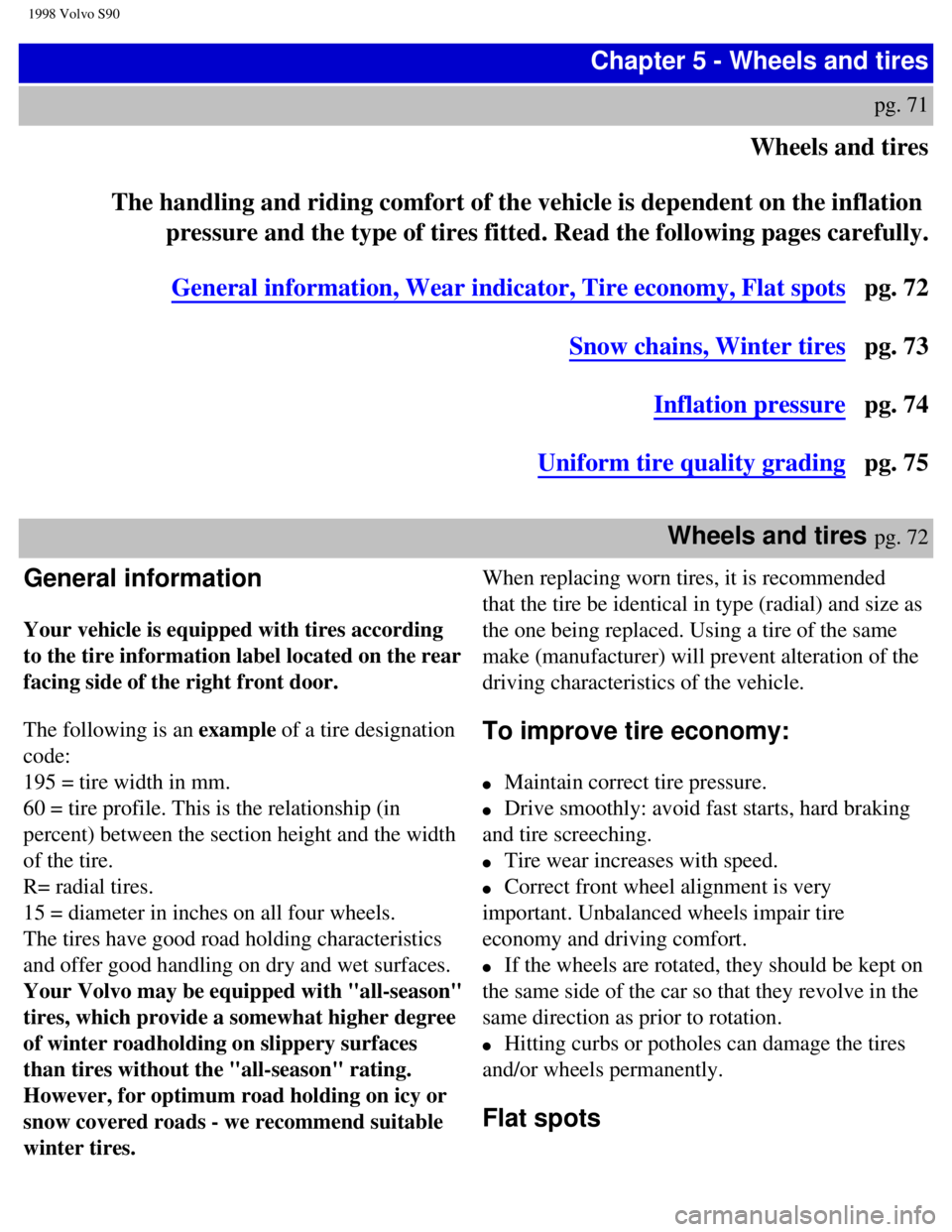
1998 Volvo S90
Chapter 5 - Wheels and tires
pg. 71
Wheels and tires
The handling and riding comfort of the vehicle is dependent on the infla\
tion
pressure and the type of tires fitted. Read the following pages carefull\
y.
General information, Wear indicator, Tire economy, Flat spots pg. 72
Snow chains, Winter tires pg. 73
Inflation pressure pg. 74
Uniform tire quality grading pg. 75
Wheels and tires
pg. 72
General information
Your vehicle is equipped with tires according
to the tire information label located on the rear
facing side of the right front door.
The following is an example of a tire designation
code:
195 = tire width in mm.
60 = tire profile. This is the relationship (in
percent) between the section height and the width
of the tire.
R= radial tires.
15 = diameter in inches on all four wheels.
The tires have good road holding characteristics
and offer good handling on dry and wet surfaces.
Your Volvo may be equipped with "all-season"
tires, which provide a somewhat higher degree
of winter roadholding on slippery surfaces
than tires without the "all-season" rating.
However, for optimum road holding on icy or
snow covered roads - we recommend suitable
winter tires. When replacing worn tires, it is recommended
that the tire be identical in type (radial) and size as
the one being replaced. Using a tire of the same
make (manufacturer) will prevent alteration of the
driving characteristics of the vehicle.
To improve tire economy:
l Maintain correct tire pressure.
l Drive smoothly: avoid fast starts, hard braking
and tire screeching.
l Tire wear increases with speed.
l Correct front wheel alignment is very
important. Unbalanced wheels impair tire
economy and driving comfort.
l If the wheels are rotated, they should be kept on
the same side of the car so that they revolve in the
same direction as prior to rotation.
l Hitting curbs or potholes can damage the tires
and/or wheels permanently.
Flat spots
file:///K|/ownersdocs/1998/1998_SV90/98S90_071.htm (1 of 5)12/30/2006 \
1:52:44 PM
Page 83 of 175
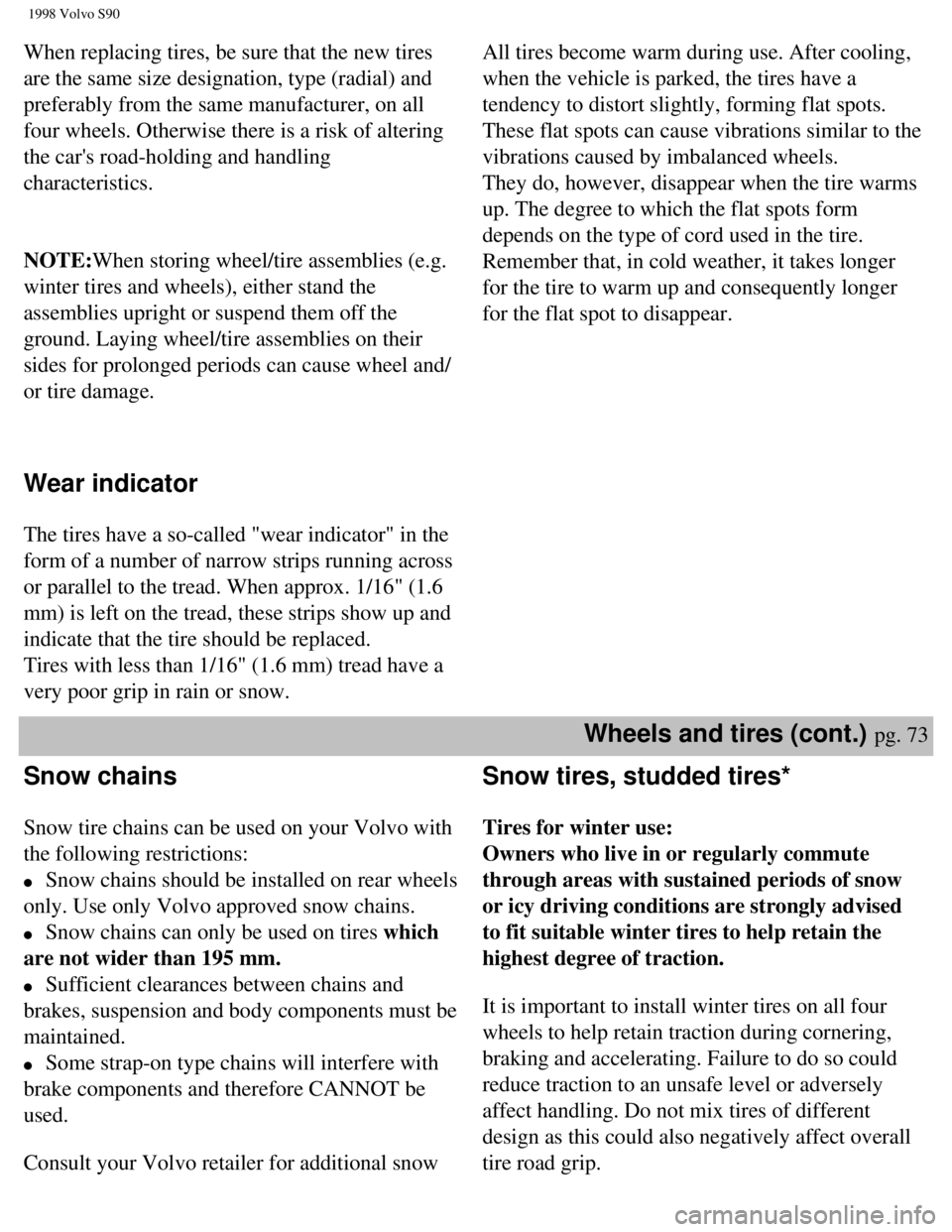
1998 Volvo S90
When replacing tires, be sure that the new tires
are the same size designation, type (radial) and
preferably from the same manufacturer, on all
four wheels. Otherwise there is a risk of altering
the car's road-holding and handling
characteristics.
NOTE:When storing wheel/tire assemblies (e.g.
winter tires and wheels), either stand the
assemblies upright or suspend them off the
ground. Laying wheel/tire assemblies on their
sides for prolonged periods can cause wheel and/
or tire damage.
Wear indicator
The tires have a so-called "wear indicator" in the
form of a number of narrow strips running across
or parallel to the tread. When approx. 1/16" (1.6
mm) is left on the tread, these strips show up and
indicate that the tire should be replaced.
Tires with less than 1/16" (1.6 mm) tread have a
very poor grip in rain or snow.
All tires become warm during use. After cooling,
when the vehicle is parked, the tires have a
tendency to distort slightly, forming flat spots.
These flat spots can cause vibrations similar to the
vibrations caused by imbalanced wheels.
They do, however, disappear when the tire warms
up. The degree to which the flat spots form
depends on the type of cord used in the tire.
Remember that, in cold weather, it takes longer
for the tire to warm up and consequently longer
for the flat spot to disappear.
Wheels and tires (cont.) pg. 73
Snow chains
Snow tire chains can be used on your Volvo with
the following restrictions:
l Snow chains should be installed on rear wheels
only. Use only Volvo approved snow chains.
l Snow chains can only be used on tires which
are not wider than 195 mm.
l Sufficient clearances between chains and
brakes, suspension and body components must be
maintained.
l Some strap-on type chains will interfere with
brake components and therefore CANNOT be
used.
Consult your Volvo retailer for additional snow
Snow tires, studded tires*
Tires for winter use:
Owners who live in or regularly commute
through areas with sustained periods of snow
or icy driving conditions are strongly advised
to fit suitable winter tires to help retain the
highest degree of traction.
It is important to install winter tires on all four
wheels to help retain traction during cornering,
braking and accelerating. Failure to do so could
reduce traction to an unsafe level or adversely
affect handling. Do not mix tires of different
design as this could also negatively affect overall
tire road grip.
file:///K|/ownersdocs/1998/1998_SV90/98S90_071.htm (2 of 5)12/30/2006 \
1:52:44 PM
Page 84 of 175
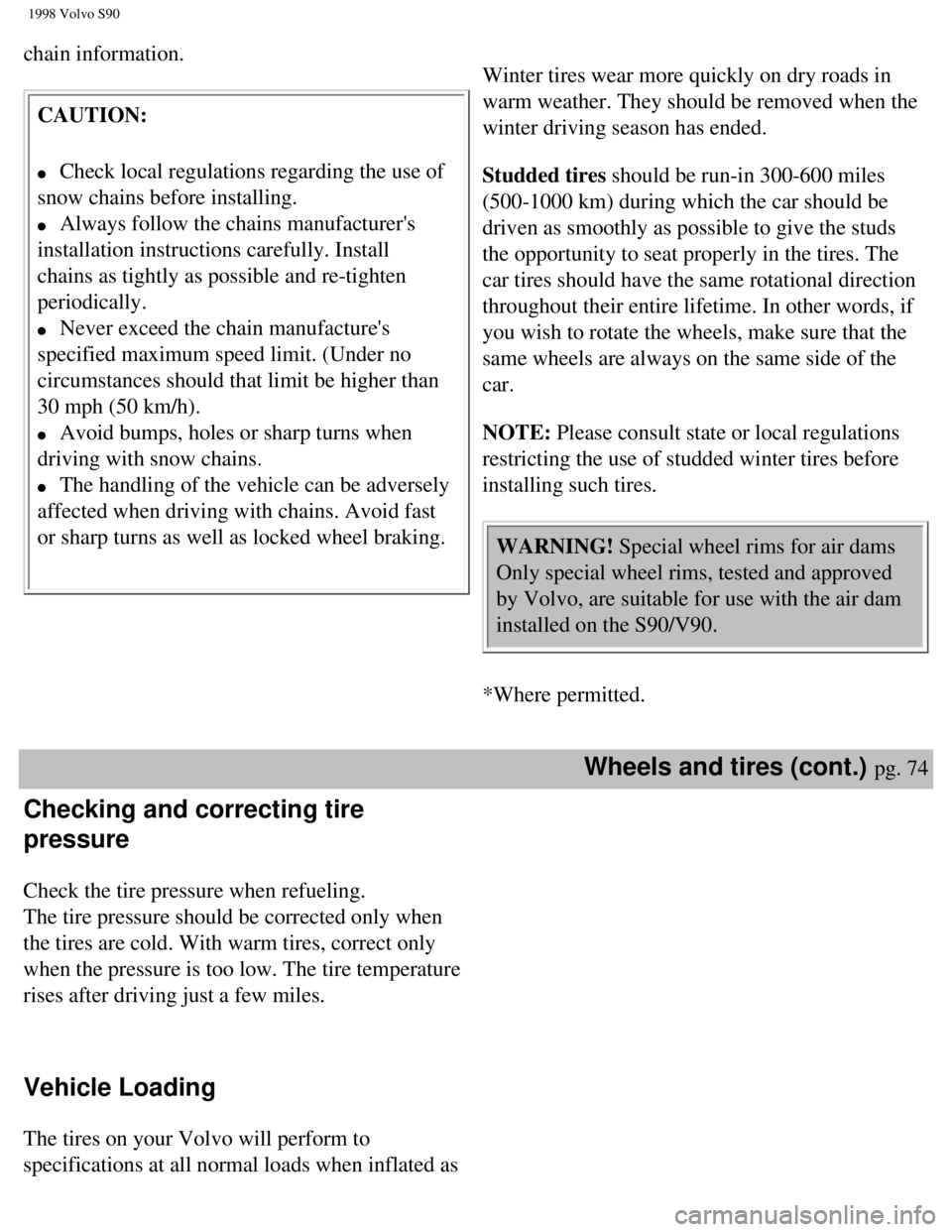
1998 Volvo S90
chain information.
CAUTION:
l Check local regulations regarding the use of
snow chains before installing.
l Always follow the chains manufacturer's
installation instructions carefully. Install
chains as tightly as possible and re-tighten
periodically.
l Never exceed the chain manufacture's
specified maximum speed limit. (Under no
circumstances should that limit be higher than
30 mph (50 km/h).
l Avoid bumps, holes or sharp turns when
driving with snow chains.
l The handling of the vehicle can be adversely
affected when driving with chains. Avoid fast
or sharp turns as well as locked wheel braking.
Winter tires wear more quickly on dry roads in
warm weather. They should be removed when the
winter driving season has ended.
Studded tires should be run-in 300-600 miles
(500-1000 km) during which the car should be
driven as smoothly as possible to give the studs
the opportunity to seat properly in the tires. The
car tires should have the same rotational direction
throughout their entire lifetime. In other words, if
you wish to rotate the wheels, make sure that the
same wheels are always on the same side of the
car.
NOTE: Please consult state or local regulations
restricting the use of studded winter tires before
installing such tires.
WARNING! Special wheel rims for air dams
Only special wheel rims, tested and approved
by Volvo, are suitable for use with the air dam
installed on the S90/V90.
*Where permitted.
Wheels and tires (cont.) pg. 74
Checking and correcting tire
pressure
Check the tire pressure when refueling.
The tire pressure should be corrected only when
the tires are cold. With warm tires, correct only
when the pressure is too low. The tire temperature
rises after driving just a few miles.
Vehicle Loading
The tires on your Volvo will perform to
specifications at all normal loads when inflated as
file:///K|/ownersdocs/1998/1998_SV90/98S90_071.htm (3 of 5)12/30/2006 \
1:52:44 PM
Page 85 of 175
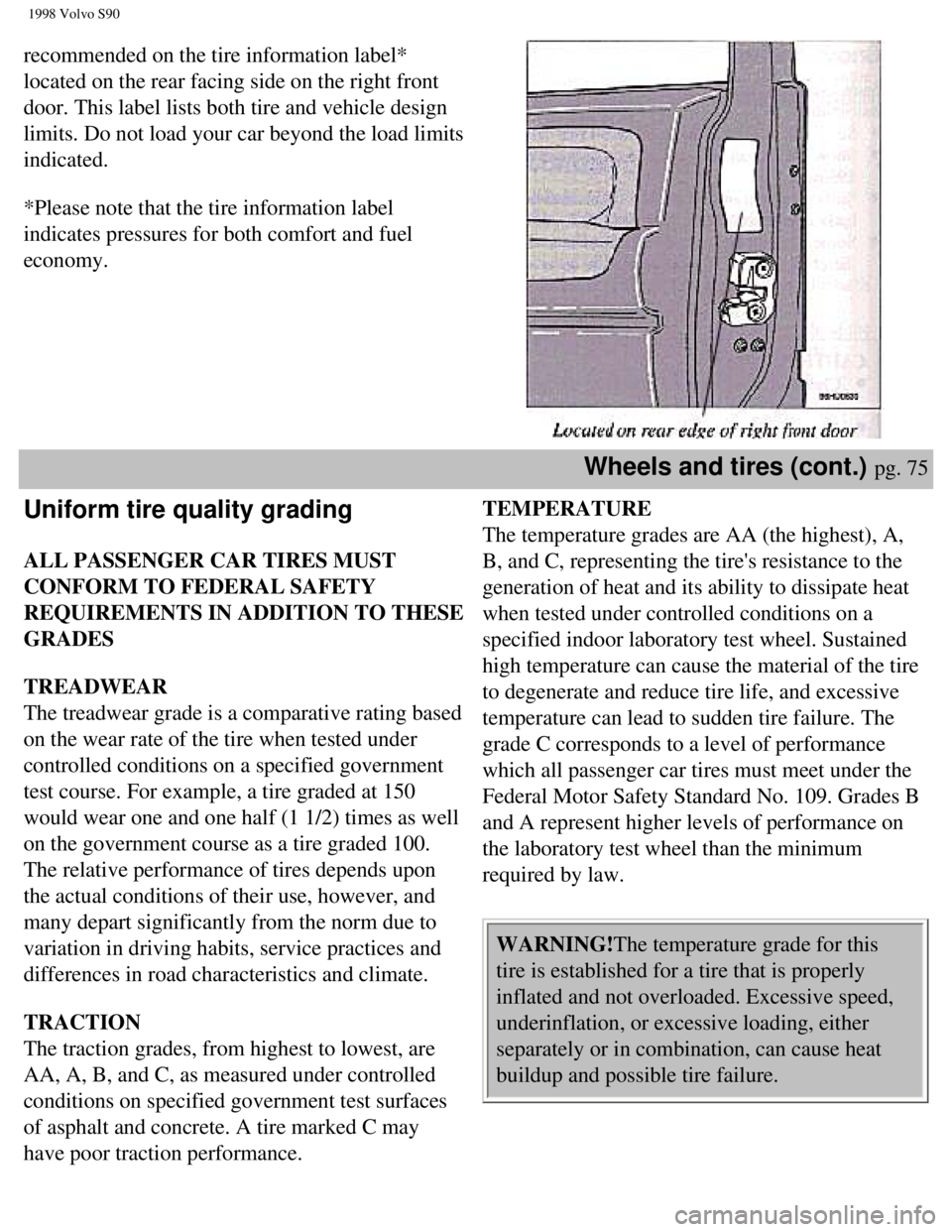
1998 Volvo S90
recommended on the tire information label*
located on the rear facing side on the right front
door. This label lists both tire and vehicle design
limits. Do not load your car beyond the load limits
indicated.
*Please note that the tire information label
indicates pressures for both comfort and fuel
economy.
Wheels and tires (cont.) pg. 75
Uniform tire quality grading
ALL PASSENGER CAR TIRES MUST
CONFORM TO FEDERAL SAFETY
REQUIREMENTS IN ADDITION TO THESE
GRADES
TREADWEAR
The treadwear grade is a comparative rating based
on the wear rate of the tire when tested under
controlled conditions on a specified government
test course. For example, a tire graded at 150
would wear one and one half (1 1/2) times as well
on the government course as a tire graded 100.
The relative performance of tires depends upon
the actual conditions of their use, however, and
many depart significantly from the norm due to
variation in driving habits, service practices and
differences in road characteristics and climate.
TRACTION
The traction grades, from highest to lowest, are
AA, A, B, and C, as measured under controlled
conditions on specified government test surfaces
of asphalt and concrete. A tire marked C may
have poor traction performance. TEMPERATURE
The temperature grades are AA (the highest), A,
B, and C, representing the tire's resistance to the
generation of heat and its ability to dissipate heat
when tested under controlled conditions on a
specified indoor laboratory test wheel. Sustained
high temperature can cause the material of the tire
to degenerate and reduce tire life, and excessive
temperature can lead to sudden tire failure. The
grade C corresponds to a level of performance
which all passenger car tires must meet under the
Federal Motor Safety Standard No. 109. Grades B
and A represent higher levels of performance on
the laboratory test wheel than the minimum
required by law.
WARNING!The temperature grade for this
tire is established for a tire that is properly
inflated and not overloaded. Excessive speed,
underinflation, or excessive loading, either
separately or in combination, can cause heat
buildup and possible tire failure.
file:///K|/ownersdocs/1998/1998_SV90/98S90_071.htm (4 of 5)12/30/2006 \
1:52:44 PM
Page 86 of 175
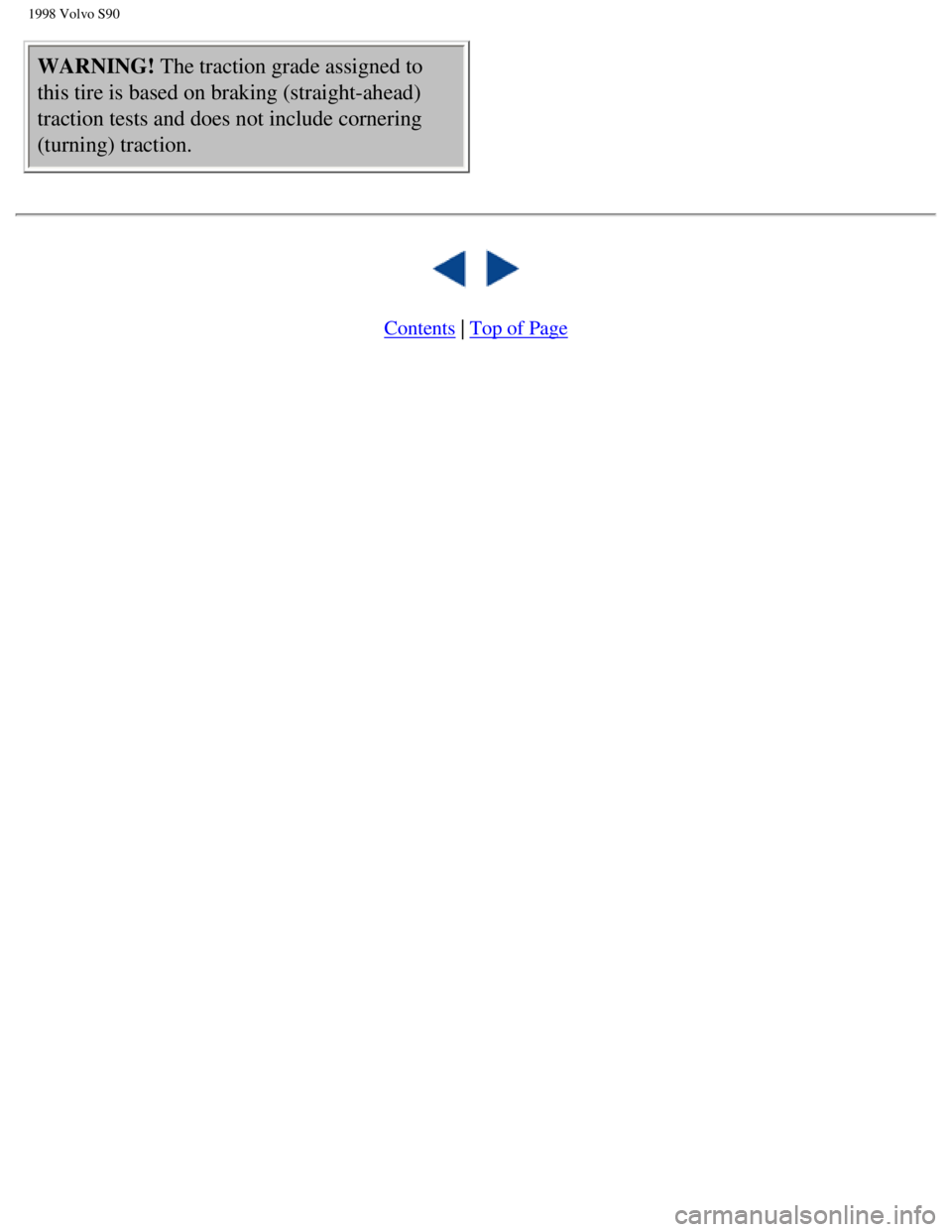
1998 Volvo S90
WARNING! The traction grade assigned to
this tire is based on braking (straight-ahead)
traction tests and does not include cornering
(turning) traction.
Contents | Top of Page
file:///K|/ownersdocs/1998/1998_SV90/98S90_071.htm (5 of 5)12/30/2006 \
1:52:44 PM
Page 87 of 175
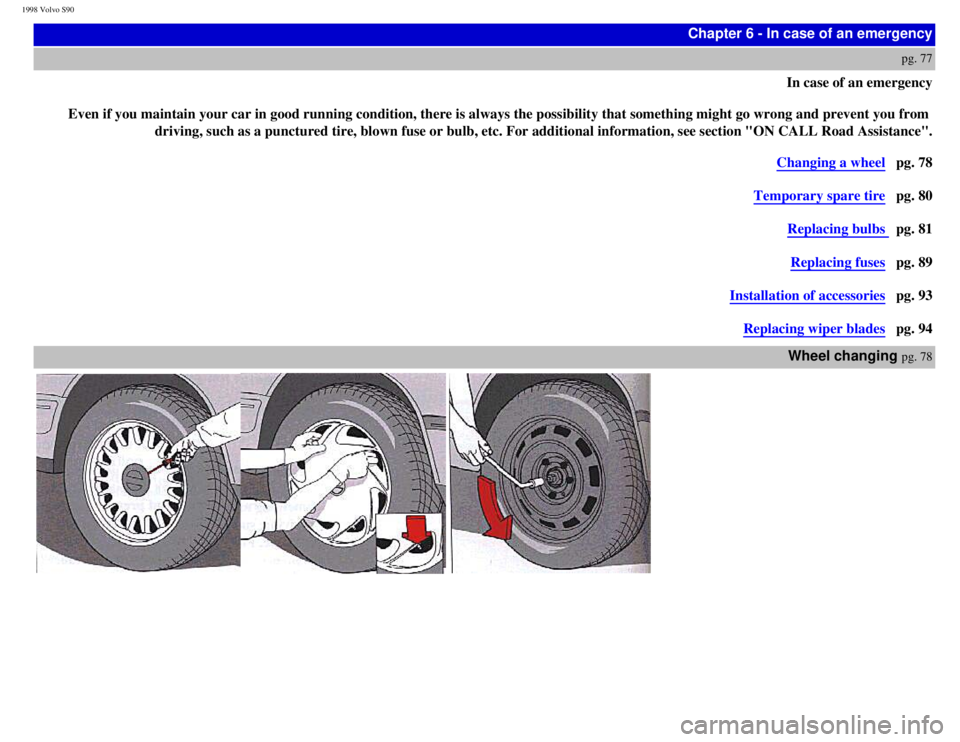
1998 Volvo S90
Chapter 6 - In case of an emergency
pg. 77
In case of an emergency
Even if you maintain your car in good running condition, there is always\
the possibility that something might go wrong and prevent you from
driving, such as a punctured tire, blown fuse or bulb, etc. For addition\
al information, see section "ON CALL Road Assistance".
Changing a wheel pg. 78
Temporary spare tire pg. 80
Replacing bulbs pg. 81
Replacing fuses pg. 89
Installation of accessories pg. 93
Replacing wiper blades pg. 94
Wheel changing
pg. 78
file:///K|/ownersdocs/1998/1998_SV90/98S90_077.htm (1 of 4)12/30/2006 \
1:52:45 PM
Page 88 of 175
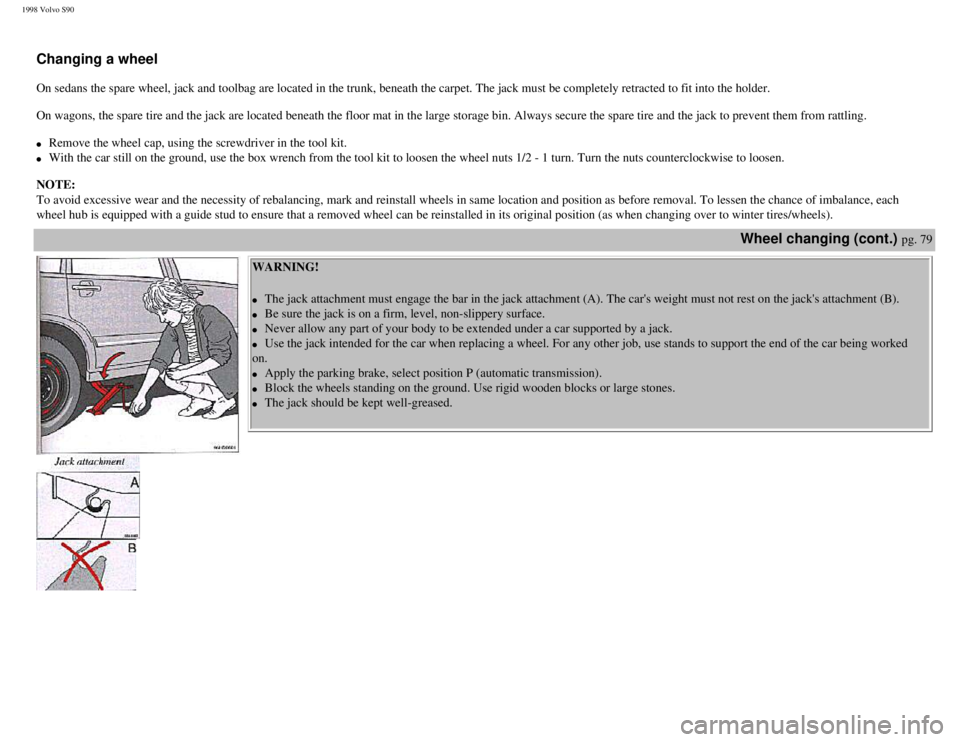
1998 Volvo S90
Changing a wheel
On sedans the spare wheel, jack and toolbag are located in the trunk, be\
neath the carpet. The jack must be completely retracted to fit into the holder.
On wagons, the spare tire and the jack are located beneath the floor mat\
in the large storage bin. Always secure the spare tire and the jack to prevent them from rattling.
l Remove the wheel cap, using the screwdriver in the tool kit.
l With the car still on the ground, use the box wrench from the tool kit t\
o loosen the wheel nuts 1/2 - 1 turn. Turn the nuts counterclockwise to loosen.
NOTE:
To avoid excessive wear and the necessity of rebalancing, mark and reins\
tall wheels in same location and position as before removal. To lessen the chance of imbalance, each
wheel hub is equipped with a guide stud to ensure that a removed wheel c\
an be reinstalled in its original position (as when changing over to winter tires/wheels).
Wheel changing (cont.) pg. 79
WARNING!
l The jack attachment must engage the bar in the jack attachment (A). Th\
e car's weight must not rest on the jack's attachment (B).
l Be sure the jack is on a firm, level, non-slippery surface.
l Never allow any part of your body to be extended under a car supported b\
y a jack.
l Use the jack intended for the car when replacing a wheel. For any other \
job, use stands to support the end of the car being worked
on.
l Apply the parking brake, select position P (automatic transmission). \
l Block the wheels standing on the ground. Use rigid wooden blocks or larg\
e stones.
l The jack should be kept well-greased.
file:///K|/ownersdocs/1998/1998_SV90/98S90_077.htm (2 of 4)12/30/2006 \
1:52:45 PM
Page 89 of 175
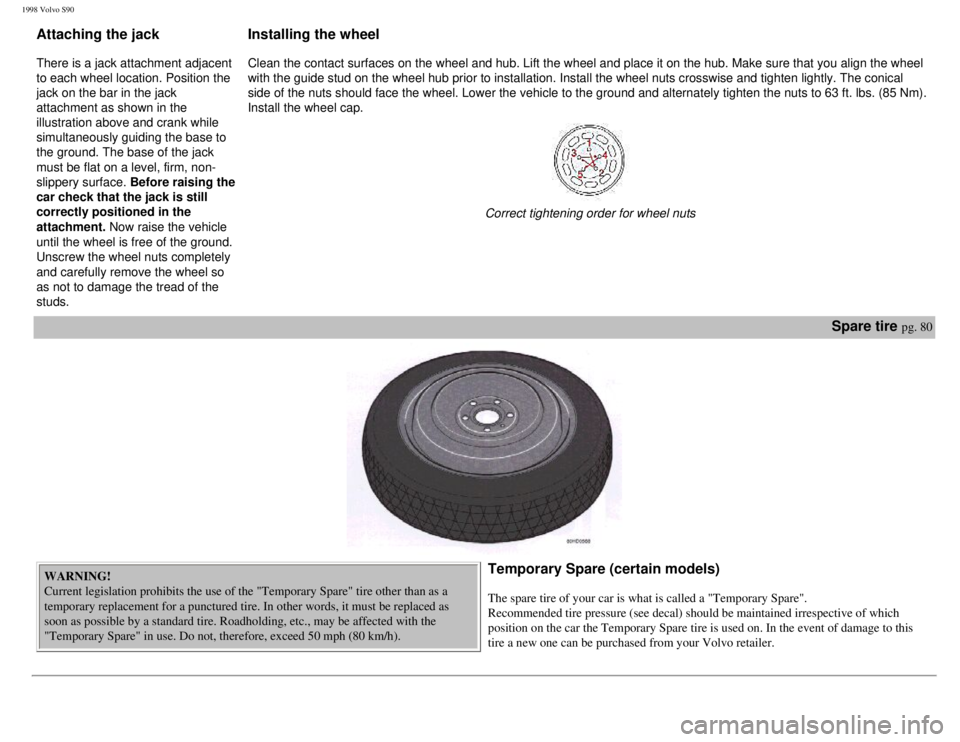
1998 Volvo S90
Attaching the jack
There is a jack attachment adjacent
to each wheel location. Position the
jack on the bar in the jack
attachment as shown in the
illustration above and crank while
simultaneously guiding the base to
the ground. The base of the jack
must be flat on a level, firm, non-
slippery surface. Before raising the
car check that the jack is still
correctly positioned in the
attachment. Now raise the vehicle
until the wheel is free of the ground.
Unscrew the wheel nuts completely
and carefully remove the wheel so
as not to damage the tread of the
studs. Installing the wheel
Clean the contact surfaces on the wheel and hub. Lift the wheel and plac\
e it on the hub. Make sure that you align the wheel
with the guide stud on the wheel hub prior to installation. Install the \
wheel nuts crosswise and tighten lightly. The conical
side of the nuts should face the wheel. Lower the vehicle to the ground \
and alternately tighten the nuts to 63 ft. lbs. (85 Nm).
Install the wheel cap.
Correct tightening order for wheel nuts
Spare tire pg. 80
WARNING!
Current legislation prohibits the use of the "Temporary Spare" tire othe\
r than as a
temporary replacement for a punctured tire. In other words, it must be r\
eplaced as
soon as possible by a standard tire. Roadholding, etc., may be affected \
with the
"Temporary Spare" in use. Do not, therefore, exceed 50 mph (80 km/h). \
Temporary Spare (certain models)
The spare tire of your car is what is called a "Temporary Spare".
Recommended tire pressure (see decal) should be maintained irrespectiv\
e of which
position on the car the Temporary Spare tire is used on. In the event of\
damage to this
tire a new one can be purchased from your Volvo retailer.
file:///K|/ownersdocs/1998/1998_SV90/98S90_077.htm (3 of 4)12/30/2006 \
1:52:45 PM
Page 90 of 175

1998 Volvo S90
Contents | Top of Page
file:///K|/ownersdocs/1998/1998_SV90/98S90_077.htm (4 of 4)12/30/2006 \
1:52:45 PM